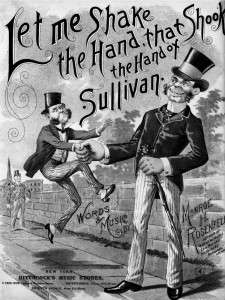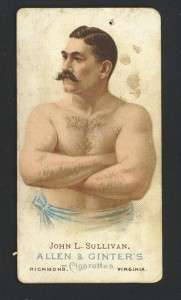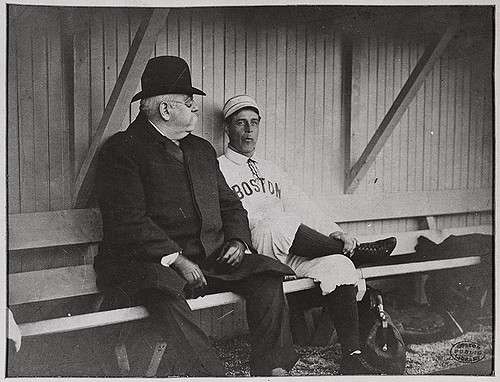“My name’s John L. Sullivan and I can lick any son-of-a-bitch alive!” If you heard those words shouted out in the 1880s, the smartest course of action was to stay seated.
 Sullivan, a.k.a. the Boston Strong Boy, would shout out this challenge dozens of times over the course of his life, and for the most part he was correct.
Sullivan, a.k.a. the Boston Strong Boy, would shout out this challenge dozens of times over the course of his life, and for the most part he was correct.
John L. Sullivan would claim to have fought more than 450 times in his career, some professionally in both exhibits and prize fights, and others the byproduct of barroom scuffles.
Like many of his stories, the truth isn’t always clear. Few people, however, attempted to correct his memory for it is safe to say that Sullivan fought a lot and was very good at it. In fact, he was what amounted to a boxing superstar in his day, harnessing his fame to earn (and spend) more than $1 million.
John L. Sullivan
John L. Sullivan was born Oct. 15, 1858 in Roxbury, Mass. His Irish immigrant parents wanted him to enter the priesthood, and he did well academically. He even attended Boston College for a few months, but dropped out to play professional baseball.
Sullivan’s career as a boxer officially began in 1878. He stepped on stage at the age of 19 to accept a challenge from a prize fighter who offered to take on any man from the audience. In such events, the fighting was typically staged with actors planted in the audience who stepped forward to take a convincing fall. Or else the actor entertained the crowd with his antics.
John L. Sullivan, however, stepped up for real and knocked the professional out. His career was under way.
Sullivan was not highly regarded for his boxing skills, but he was undoubtedly a very hard puncher. At 5’10”, his fighting weight was just under 200 pounds.

Paddy Ryan (left) and John L. Sullivan shake hands before their bout.
John L. Sullivan really made his name in 1882 with a fight against Paddy Ryan. Ryan claimed the world heavyweight championships. Any such claim to that title would raise the eyebrows of purists. In those days, most boxing in the United States involved bare knuckle fighting for as many rounds as it took for one man to get beaten until he couldn’t fight anymore.
The Paddy Ryan Fight
While the Marquess of Queensberry rules were starting to take hold, they hadn’t broadly caught on in the United States. Nor did strong organizations exist to regulate the sport. Nevertheless, Paddy Ryan was a big name and Sullivan chased him for a fight for years. In 1882, Ryan finally obliged.
The match moved several times. Its final location along the Gulf Coast in Mississippi was kept secret until shortly before it started to prevent police from intervening. In the end, it was not much of a contest. After nine rounds (some say eight), Ryan couldn’t continue and Sullivan had won.
 The victory catapulted John L. Sullivan to broader fame, and in 1884 he set out to take on the world – literally. He went on a “grand tour” of 28 states in eight months. At each stop, his crew of ‘Sullivan’s Sluggers’ would warm up the crowd with a series of boxing exhibitions. Then the real action would begin.
The victory catapulted John L. Sullivan to broader fame, and in 1884 he set out to take on the world – literally. He went on a “grand tour” of 28 states in eight months. At each stop, his crew of ‘Sullivan’s Sluggers’ would warm up the crowd with a series of boxing exhibitions. Then the real action would begin.
Sullivan would enter the ring and put up a purse, usually $50 though he raised it as high as $1,000 at times He would give it to any man who would step forward and stay on his feet for three rounds with him in the ring.
He claimed no one ever made it. Every time John L. Sullivan rolled in to a new town, a newspaper man’s dream came true. The carousing Sullivan would be the talk of the town as he drank his way up to the fight, buying booze and raising a ruckus. Trips to the local magistrate to answer charges of drunkenness were not unheard of.
All of it served as great publicity to pack the house on the night of the fights. Returning to Boston, the John L. Sullivan legend grew. In total, more than 100,000 people had come to see Sullivan, and he said he took in more than $140,000 from the tour. He was the most famous person in America.
The Greatest Fight
In July of 1889, Sullivan fought probably his greatest fight, against a fighter named Jake Kilrain. Again, the two men met in Mississippi and 3,000 people went to watch the match. It was another bare-knuckle fight for the world championship. It lasted an amazing 75 rounds. Sullivan scored the first knockdown and Kilrain drew the first blood.

Poster promoting the Kilrain-Sullivan fight
The two were very evenly matched, but the reporters who wrote about the fight noted that about round 30, Sullivan began to get the upper hand, and Kilrain’s trainer took him out of the fight at 75.
John L. Sullivan would defend his title once more in 1892 against “Gentleman Jim” Corbett. Corbett was eight years younger than Sullivan, and much more of a boxer. He relied on footwork and speed and less on punching power. Sullivan, meanwhile, hadn’t trained as hard as he had for Kilrain. The bout was fought with gloves, and in 21 rounds Sullivan was out. It was his last significant fight, though he would manage exhibitions and a minor comeback or two. Corbett would later say that seeing how the crowd had cheered Sullivan at the start of the fight and then turned on him when he was down gave him a look into his own future, and the future of all fighters.
Career Continues
John L. Sullivan made his name as a fighter, but he made most of his money as a self-promoter. When he wasn’t fighting, he was coming up with new schemes to make money. His appearances were never ending. He pitched and umpired at minor league baseball games, appeared in plays, put on boxing exhibitions, s0ld whiskey. If there was money to be made, John L. would show up.
The scandals persisted, however. His wife had accused him of abusing her (which he probably did) when he was drunk. They split and eventually divorced. He was also a straight-out racist, refusing any offers to fight black boxers.
However, after his retirement, his fame seemed to grow. He worked the political campaign trail for his friend Teddy Roosevelt and later James Michael Curley. And his fame inspired the expression: “I’d like to shake the hand that shook the hand of John L. Sullivan.”
The phrase originated from the play The Rag Baby by New Hampshire playwright Charles Hoyt. The farcical play featured a sports fan so enamored of Sullivan that he was thrilled just to shake the hand of someone who had met the fighter. The phrase would later be turned into a song by Monroe Rosenfeld (lyrics) and Alfred Williams (music). People often used the expression for decades.
Finally, Temperance
John L. Sullivan worked steadily through the 1890s, most often entertaining crowds on the vaudeville circuit with a monologue of stories than delighted his fans. He also continued his drinking ways, appearing in court from time to time to face charges that he assaulted someone or was drunk and disorderly.
Still the crowds loved him. John L. Sullivan finally quit drinking around 1908 and went on to marry his second wife, Katherine – a girl he knew from childhood. The two settled on her farm in Abington, Mass.
John L. Sullivan soon became a sought-after speaker in the temperance movement. He freely acknowledged how much alcohol had cost him, both financially and personally.
Gentleman Jim Corbett didn’t beat him for the title, he said, whiskey did. John L. Sullivan died in 1918, telling stories and entertaining his fans until the very end.
This story about John L. Sullivan was updated in 2023.


6 comments
Thank you for writing about an unsung figure in sports and America’s cultural history. If sports are America’s secular faith, John L. Sullivan wasn’t just among the pantheon of our first athletic gods, he was our Zeus. Sullivan blazed the path for all athletes who came after him. His greatest victory, indeed, was against the bottle when he gave up drinking in 1905.
Christopher Klein
Author, Strong Boy: The Life and Times of John L. Sullivan, America’s First Sports Hero
Thank you for writing about an unsung figure in sports and America’s cultural history. If sports are America’s secular faith, John L. Sullivan wasn’t just among the pantheon of our first athletic gods, he was our Zeus. Sullivan blazed the path for all athletes who came after him. His greatest victory, indeed, was against the bottle when he gave up drinking in 1905.–Christopher Klein, Author of Strong Boy: The Life and Times of John L. Sullivan
Boxing rowing and horse racing were the sports of the era. Some pretty famous oarsmen of that day Courtney and Hanlan come to mind
[…] something I remember my grandfather saying growing up, “Shake the hand that shook the hand of John L Sullivan.” Just thought of it right now. Memories are funny like that. Back to our regularly […]
[…] took up boxing in the navy, where he won 38 fights. His ship’s home port was Boston, and he fought for pay on […]
[…] in Boston Corners. The court fined him $1,200, but the fight had made news all over the country. It made Morrissey a star. He opened one, then several, successful gambling establishments. He co-founded the Saratoga Race […]
Comments are closed.